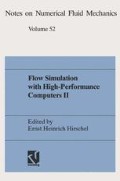Summary
The first section gives a description of the numerical procedure which is used for the integration of structured grid blocks. Such blocks are the basic elements of the self-adaptive grid structure. A hierarchically ordered level system, which reflects different refinement stages, serves as a scaffold. After a description of sensors used for refining interesting flow phenomena, an overview about the integration steps is given. The application of AMRFLEX3D to the cases of a three-dimensional, inviscid, supersonic corner flow and of a delta wing at transonic flow conditions is presented. For the latter simulation, both Euler and Navier-Stokes equations are used. Conclusions that can be drawn from experiences with grid refinement investigations are given.
Access this chapter
Tax calculation will be finalised at checkout
Purchases are for personal use only
Preview
Unable to display preview. Download preview PDF.
References
Dadone, A., AND Grossman, B. Surface Boundary Conditions for the Numerical Solution of the Euler Equations. AIAA Journal 32, 2 (1994), 285–293.
Eberle, A. Characteristic Flux Averaging Approach to the Solution of Eulers Equations. VKI-Lecture Series 1987-04, 1987.
Elsenaar, A. Summary of NLR Wind Tunnel Tests on the International Vortex Flow Model. Tech. Rep. Memorandum AC-87-023 L, NLR, 1987.
Elsenaar, A., AND Hoeijmakers, H. An Experimental Study of the Flow over a Sharp-Edged Delta Wing at Subsonic and Transonic Speeds. In Vortex Flow Aerodynamics (1991), pp. 15-1–15-19. AGARD-CP-494.
Fischer, J.Sensors for Self-Adapting Grid Generation in Viscous Flow Computations, Vol. 35 of NNFM. Vieweg, Braunschweig/Wiesbaden, 1992, pp. 365–375.
Fischer, J. Selbstadaptive, lokale Netzverfeinerung für die numerische Simulation kompressibler, reibungsbehafteter Strömungen. Doctoral Thesis, 1993. Universität Stuttgart.
Fischer, J. Self-adaptive mesh refinement for the computation of steady, compressible, viscous flows. Z. Flugwiss. Weltraumforsch. 18 (1994), 241–252.
Fischer, J., AND Hirschel, E. H.Adaptive Navier-Stokes Calculations Using a Combination of an Implicit Finite — Volume Method with a Hierarchically Ordered Grid Structure, Vol. 38 of NNFM. Vieweg, Braunschweig/Wiesbaden, 1993, pp. 279–294. Flow Simulation with High Performance Computers I.
Greza, H., Bikker, S., AND Koschel, W. Efficient FEM Flow Simulation on Unstructured Adaptive Meshes. In this publication.
Hentschel, R. Entwicklung und Anwendung eines dreidimensionalen selbstadap-tiven Verfahrens auf der Basis strukturierter Gitter. Doctoral Thesis, 1996. Universität Stuttgart.
Hentschel, R., AND Hirschel, E. H. Self Adaptive Flow Computations on Structured Grids. In Computational Fluid Dynamics —94 (September 1994), S. Wagner, E. H. Hirschel, J. Periaux, and R. Piva, Eds., John Wiley & Sons, pp. 242–249.
Landgrebe, A. J. New Directions in Rotorcraft Computational Aerodynamics Research in the U.S. In Aerodynamics and Aeroacoustics of Rotorcraft (1995), pp. 1-1–1-12. AGARD-CP-552.
Marsilio, R. Vortical Solutions in Supersonic Corner Flows. AIAA Journal 31 (1993), 1651–1658.
Michl, T. Effiziente Euler-und Navier-Stokes Löser für den Einsatz auf Vektor-Hochleistungsrechnern und massiv-parallelen Systemen. Doctoral Thesis, 1995. Universität Stuttgart.
Schmatz, M. A.Three-Dimensional Viscous Flow Simulations Using An Implicit Relaxation Scheme, Vol. 22 of NNFM. Vieweg, Braunschweig/Wiesbaden, 1987, pp. 226–243. Numerical Simulation of the Transonic DFVLR-F5 Wing Experiment.
Schwarz, W. IEPG-TA15 Aerodynamische Berechnungsverfahren, Teil 2. Tech. Rep. DASA/LME211/S/R/1619, DASA-LM, 1993.
Vilsmeier, R., AND Hänel, D. Computational Aspects of Flow Simulation on 3-D, Unstructured, Adaptive Grids. In this publication.
Author information
Authors and Affiliations
Editor information
Editors and Affiliations
Rights and permissions
Copyright information
© 1996 Friedr. Vieweg & Sohn Verlagsgesellschaft mbH, Braunschweig/Wiesbaden
About this chapter
Cite this chapter
Hentschel, R., Hirschel, E.H. (1996). AMRFLEX3D — Flow Simulation Using a Three-Dimensional Self-Adaptive, Structured Multi-Block Grid System. In: Hirschel, E.H. (eds) Flow Simulation with High-Performance Computers II. Notes on Numerical Fluid Mechanics (NNFM), vol 48. Vieweg+Teubner Verlag. https://doi.org/10.1007/978-3-322-89849-4_29
Download citation
DOI: https://doi.org/10.1007/978-3-322-89849-4_29
Publisher Name: Vieweg+Teubner Verlag
Print ISBN: 978-3-322-89851-7
Online ISBN: 978-3-322-89849-4
eBook Packages: Springer Book Archive

